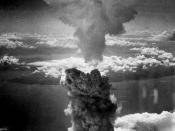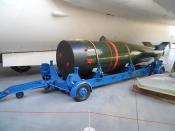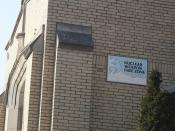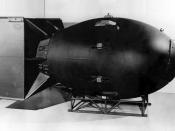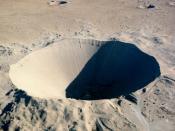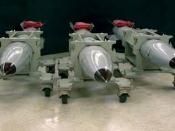Nuclear War Have you ever thought about nuclear war and how it affects your everyday life? In a madder of minutes large parts of are country can be taken out by nuclear bombs. Nuclear consists of many different types of nuclear artillery and, many types of planes and submarines. Also it consists of many effects, accidents, and a history of attacks. These aspects of nuclear war range far from any other type of war.
First, are the types of artillery in nuclear war. One kind of artillery would be the Redstone (SSM-A-14) medium range ballistic missile. This missile is 69 feet long. The weight is 61,346 pounds. These missiles speed gets up to mach 5.5. The missiles speed at impact is mach 2.3. Also it has a range of 56.6 to 201.5 miles. This missile is built with a single W-39 thermonuclear warhead, with a 4-megaton yield. Another missile is the Sprint.
This missile is about half the size of Redstone. Its length is 26 feet 11 inches. The weight of this missile is 7,700 pounds. When set off it can get up to supersonic speeds. Its range is around 25 miles. This missile is made up of a single W-66 thermonuclear warhead, with a 20 kt yield. It destroys targets by a neutron flux produced by the warhead. Nuclear artillery also consists of nuclear guns. An example of one is the Davy Crocket gun. This gun isn't big but can cause a lot of damage. Its length is 8 feet 2 inches. The weight is 371 pounds. A good aspect of this gun is that it can range from 1000 feet to 2.5 miles. The gun shoots conventional or W-4 variable yield fission devices. This gun destroys large tanks and infantry. Also there are missiles that are made for submarines. One of them is the Suborc (UUM-44A) this missile can get as long as 21 feet. The speed is supersonic. This missile ranges around 28.5 miles. It is a single W-55 fission warhead (Gibson, James Norris pg. 158,170,179-180).
Another part of artillery, but bigger impacts on nuclear war is the planes and submarines that carry the bombs. Through many years different planes were upgraded or invented. One of the planes was the P2v-3C Neptune. This plane has a length of 77 feet and, has a height of 21 feet 1 inch. The Neptune's max speed is 300 mph. The Neptune comes equipped with a little boy bomb, mk-1, Betty, or with just two lulu depth bombs. Another plane is the B-2 (ATB). The length of this plane isn't that much smaller than the Neptune. It is 69 feet long, with a height of 15 feet. Unlike the Neptune the speed for this plane is supersonic. The last but my most favorite plane is the F-15 eagle. This plane is smaller than the other two but looks much stronger. Its length is 63 feet 9 inches, and has a height of 18 feet 8 inches. The speed of this plane gets up to a mach 2.5. This plane carries a B-43, B-61, and a B-83 bomb. When bombs aren't up in the air they are being carried under water by huge submarines. The two submarines that caught my eye were the Los Angeles Class and the Ohio Class. The Los Angeles Class is a significant 360 feet long. This sub weighs 6,900 tons on the surface and 7,880 tons submerged. This submarine gets up to 30 knots when submerged. It carries 12 vertical launch tubes for the tomahawk, four mid-ship 21-inch torpedo tubes also for the tomahawk. Also comes with a subroc missile and MK-48 torpedoes. Not as small as the Los Angeles Class, the Ohio Class is 560 feet long. Also has a weight of 16,600 tons on the surface and, 18,750 tons submerged. This submarine carries 24 launch tubes for trident missiles and, four 21-inch torpedo tubes (Gibson, James Norris pg. 107,126,138,48-49,52-53).
The main thing that makes nuclear war so bad is its effects to living things and are resources. When nuclear bombs hit places thing go off in steps. The first step would be the blast wave. The effects of this start out as a huge fireball that consists of dust, hot gases, and high pressure. While in the fireball the gases will start to expand. This blast wave can travel up to about 12 miles long. A couple of seconds after the explosion, the fireball makes atmospheric pressure. This pressure will destroy most buildings that are 1 mile away. These blast waves also create huge wind that get up to 400 mph. Two miles from ground zero. This blast wave should kill most be that are at ground zero or 3 miles away. Later after the explosion a thermal radiation will occur. The effects of this can be very harmful. It consists of ultraviolet, visible, and infrared radiation. The ultraviolet absorbs particles in the air like dust and rocks. That makes little damage. On the other hand the visible and infrared can cause eye injuries and skin burns called flash burns. This radiation can ignite flammable materials such as newspapers and dry leaves. Another effect of thermal radiation is that smoke from fibers can absorb enough sunlight to lower the temperature of the earth for many months or years. This can result in a wide spread crop failure and famine. Another step is Residual Radiation. This is created by fission. It consists of gamma rays and beta particles. This strikes rocks, soil, water and other particles. When those particles are hit they become radioactive. This step has to phases an early fall out and a delayed fall out. The early fall out consists of big particles that reach the ground from the time of the explosion to 24 hours after. This is extremely radioactive. This will kill many living things. The delayed fall out reaches the ground 24 hours up to a number of years. This consists of tiny and often invisible particles. These fall in small amounts in large areas. This can cause long-term radiation damage to living things (The World Book pg. 598-599).
The problem with having all of this nuclear artillery is that accidents could happen. Accidents with nuclear bombs have occurred one to many times. For instance on April 11, 1950 a B-29 bomber crashes in a mountain on Manzano Base near Kirtland Air Force Base in New Mexico. The bomb exploded but the capsule, which wasn't inserted in the bomb, was found intact. Another accident was on March 11, 1958 a B-47 bomber accidentally drops a nuclear weapon on Mars Buff, South Carolina. It left 75 feet wide by 35 feet deep hole. That is already two accidents of many that could have did a lot more damage then they did. Another accident was on January 23, 1961. A b_52 bomber crashes at Golds Boro, North Carolina. This bomber was carrying two 24-megaton bombs. Five of six interlocking safety devices failed, a single switch prevents the bombs from going off. Those two bombs were 1,800 times more powerful than the one's dropped on Hiroshima. Next there was and mess up on January 17,1966 a B-22 bomber has a mid-air accident, while trying to refuel. It drops 4 nuclear weapons on Palomares, Spain. Luckily no explosions occurred, but conventional explosions in 2 of the weapons scatter radioactive material over a populated area. Last was an accident on January 14, 1969. A Bomb dropped on a deck of the nuclear-powered aircraft carrier USS Enterprise. This killed 25 and wounded 85 crewmen (http://www.nuclearfiles.org/nwa/short-list.html).
Nuclear War has a small but bitter history. It stared when the United States bombed Hiroshima. We used a gun-typed fission bomb. The bomb was dropped by a B-29 aircraft. This killed 70,000 to 100,00 people. This happened on August 6,1945. The other bombing happened 3 days later after Hiroshima. A B-29 dropped a similar bomb but bigger. The problem was that the smaller bomb in Hiroshima kills more people than the larger one in Nagasaki. This bomb only killed 4,000 people because of the hilly terrain (World Book pg.601-602)
